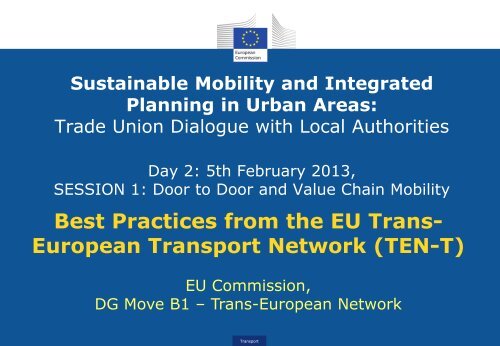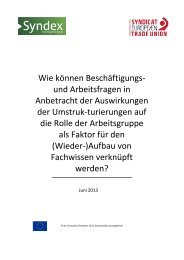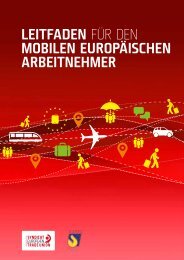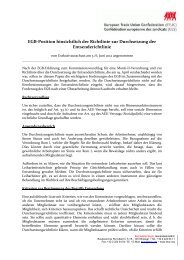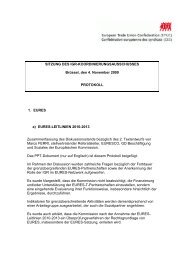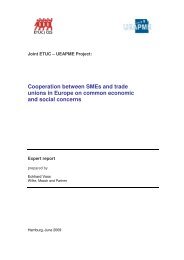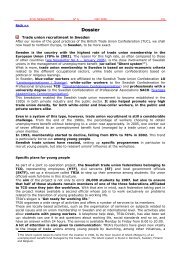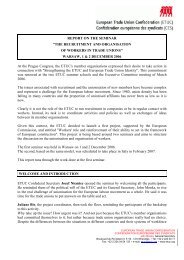Herald Ruijters - ETUC
Herald Ruijters - ETUC
Herald Ruijters - ETUC
Create successful ePaper yourself
Turn your PDF publications into a flip-book with our unique Google optimized e-Paper software.
Sustainable Mobility and Integrated<br />
Planning in Urban Areas:<br />
Trade Union Dialogue with Local Authorities<br />
Day 2: 5th February 2013,<br />
SESSION 1: Door to Door and Value Chain Mobility<br />
Best Practices from the EU Trans-<br />
European Transport Network (TEN-T)<br />
EU Commission,<br />
DG Move B1 – Trans-European Network<br />
Transport
Introduction: TEN-T Policy<br />
Establishing an efficient trans-European<br />
transport network (TEN-T) is a key element<br />
in the re-launched Lisbon Strategy for<br />
competitiveness and employment in<br />
Europe, play a central role for the Europe<br />
2020 Strategy<br />
Transport<br />
2
TEN-T Policy Goals<br />
• TEN-T policies and projects aim to:<br />
- Promote a genuine network approach as a basis<br />
for sustainable transport policy<br />
- Establish and develop key links and<br />
interconnections needed to eliminate existing<br />
bottlenecks to mobility<br />
- Fill in missing sections and complete the main<br />
routes, especially their cross-border sections<br />
- Cross natural barriers<br />
- Improve interoperability on major routes<br />
Transport<br />
3
Background:<br />
The EU transport policy vision 2050<br />
• Roadmap to a single European<br />
Transport Area – towards a<br />
ressource efficient transport<br />
system (White Paper, 2011)<br />
Reducing CO2-emissions by 60% while<br />
meeting increasing mobility needs<br />
Transport<br />
4
New TEN-T legislation in preparation<br />
Two EU Regulations have been<br />
proposed in 2011:<br />
• Union Guidelines for the<br />
development of the trans-<br />
European transport network,<br />
governing infrastructure planning<br />
and implementation until 2050<br />
• The Connecting Europe Facility<br />
governing EU funding until 2020<br />
Transport<br />
5
New TEN-T Guidelines: a comprehensive<br />
infrastructure development concept, Horizon 2050<br />
• A multi-modal network with binding<br />
infrastructure standards, based on EU<br />
law and international agreements<br />
• An increased emphasis on nodes,<br />
both urban nodes and transport nodes<br />
• A reinforced link between infrastructure<br />
functionality and infrastructure development<br />
• A framework for Intelligent Transport Services to boost<br />
efficient infrastructure use, technological innovation to<br />
enable low carbon solutions<br />
Transport<br />
6
New TEN-T Guidelines: the core network<br />
• The strategically most important part of the<br />
TEN-T, outcome of the first genuinely<br />
European transport network planning method<br />
• A multi-modal NETWORK approach in<br />
contrast to the current, uni-modal priority<br />
projects' approach<br />
• A forerunner of ressource-efficient, intelligent and<br />
innovative infrastructure development in the entire EU<br />
• An implementation priority (target 2030), with strong<br />
support from financial and non-financial EU instruments<br />
Transport<br />
7
Implementation and Financing Instruments<br />
• TEN-T Guidelines and Corridors<br />
• Connecting Europe Facility<br />
• CIVITAS<br />
• EU Cohesion and Regional Funds<br />
• Seventh Framework Programme for<br />
Research and Technological Development<br />
• Intelligent Energy Europe programme (STEER)<br />
Transport<br />
8
New TEN-T Guidelines: Urban Nodes - Context<br />
• A majority of trips along TEN-T originate/end at urban<br />
nodes, resulting in challenges regarding capacity/quality:<br />
- Long-distance, regional and urban traffic overlap, stretching<br />
the limits of infrastructures;<br />
- noise, toxic/carbon emissions affect citizens' quality of life;<br />
- poorly integrated networks of different transport modes (e.g.<br />
rail and air or maritime) may render long-distance passenger<br />
or freight traffic inefficient and inattractive<br />
- poorly connected networks for long-distance and urban<br />
traffic generate time losses on the last mile for users<br />
Transport<br />
9
New TEN-T Provisions for Urban Nodes<br />
• To address challenges related to urban nodes, a specific<br />
article was introduced in the TEN-T Guidelines' proposal<br />
• for the first time, respective actors are explicitely called<br />
upon by European legislation to take relevant actions<br />
• urban nodes play a key role in shaping the core network<br />
(the EU's major economic, cultural and scientific centres<br />
are mostly important origins or destinations)<br />
• new TEN-T policy also promotes intelligent and<br />
innovative equipment of infrastructure and vehicles<br />
(advanced traffic management systems for using scarce urban<br />
infrastructure efficiently and enhancing service quality; innovative<br />
infrastructure – vehicle systems pioneering low carbon transport)<br />
Transport<br />
10
Best Practices: TEN-T in Urban Areas<br />
• High-speed rail connection to Brussels Airport: Diabolo<br />
• Going underground to provide improved rail capacity:<br />
Malmö Citytunnel<br />
• Railway tunnel in Gothenburg: allowing through-travel<br />
• Berlin transit hub: linking local, national and international<br />
• Malpensa airport rail link: connecting terminals 2 to<br />
terminal 1 and the national rail network<br />
• Intermodal passenger and freight transport infrastructure<br />
at Cluj-Napoca International Airport/Romania<br />
Transport<br />
11


